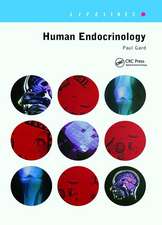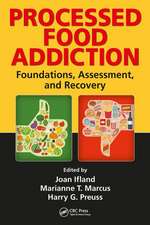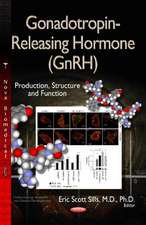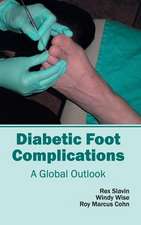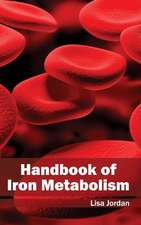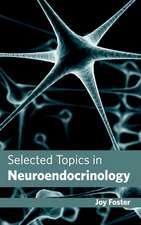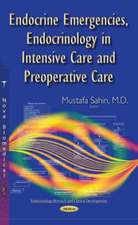Nutrition and Diabetes: Pathophysiology and Management
Editat de Emmanuel C. Opara, Sam Dagogo-Jacken Limba Engleză Hardback – 14 ian 2019
Features
- Highlights the role of nutrition in the pathogenesis of obesity and diabetes
- Organized logically into two easy-to-use sections - Pathophysiology and Management of Obesity and Pathophysiology and Treatment of Diabetes
- Features emerging therapeutic approaches for management of obesity and diabetes
- Discusses experience in the management of obesity and diabetes in developing countries
- Presents challenges in insulin therapy and provides guidelines to overcome them
| Toate formatele și edițiile | Preț | Express |
|---|---|---|
| Paperback (1) | 436.14 lei 6-8 săpt. | |
| CRC Press – 30 iun 2021 | 436.14 lei 6-8 săpt. | |
| Hardback (1) | 1247.44 lei 6-8 săpt. | |
| CRC Press – 14 ian 2019 | 1247.44 lei 6-8 săpt. |
Preț: 1247.44 lei
Preț vechi: 1521.27 lei
-18% Nou
Puncte Express: 1871
Preț estimativ în valută:
238.73€ • 248.31$ • 197.08£
238.73€ • 248.31$ • 197.08£
Carte tipărită la comandă
Livrare economică 15-29 aprilie
Preluare comenzi: 021 569.72.76
Specificații
ISBN-13: 9781138710009
ISBN-10: 1138710008
Pagini: 470
Ilustrații: 50
Dimensiuni: 178 x 254 x 30 mm
Greutate: 1.3 kg
Ediția:Nouă
Editura: CRC Press
Colecția CRC Press
Locul publicării:Boca Raton, United States
ISBN-10: 1138710008
Pagini: 470
Ilustrații: 50
Dimensiuni: 178 x 254 x 30 mm
Greutate: 1.3 kg
Ediția:Nouă
Editura: CRC Press
Colecția CRC Press
Locul publicării:Boca Raton, United States
Public țintă
Academic and Professional ReferenceCuprins
Section i Pathophysiology and treatment of obesity Chapter 1 Central and Peripheral Modulators of Appetite and Satiety Chapter 2 Genetic Determinants of Nutrient Processing Chapter 3 The Enteroinsular Axis: Contribution to Obesity-Diabetes and Its Treatments Chapter 4 Metabolic Syndrome: Recognition, Etiology, and Physical Fitness as a Component Chapter 5 Fat Distribution and Diabetes Mellitus Chapter 6 Combined Effect of Diet and Physical Activity in the Management of Obesity Chapter 7 Pharmacological Treatment of Obesity Chapter 8 The Role of Gut Microbiota in the Pathogenesis and Treatment of Obesity Chapter 9 Bariatric Surgery Chapter 10 Postoperative Nutritional Management of the Bariatric-Surgery Patient Section ii Pathophysiology and treatment of Diabetes Chapter 11 Health and Economic Burdens of Diabetes and Its Complications Chapter 12 Nutrient Interactions and Glucose Homeostasis Chapter 13 Management of Obesity-Associated Type 2 Diabetes Chapter 14 Type 2 Diabetes in Childhood: Diagnosis, Pathogenesis, Prevention, and Treatment Chapter 15 The Contribution of Iron and Transition Metal Micronutrients to Diabetes and Metabolic Disease Chapter 16 The Role of Gut Microbiota in the Pathogenesis and Treatment of Diabetes Chapter 17 Achieving a Healthy Body Weight in Later Life: Interventions to Reduce Type 2 Diabetes Risk Chapter 18 Primary Prevention of Type 2 Diabetes: From Research to Community Chapter 19 Management of Diabetes Mellitus in Sub-Saharan Africa: Focus on Nigeria Chapter 20 Gestational Diabetes: Focus on Pregestational, Gestational, and Postnatal Weight Management Chapter 21 Pathophysiology and Management of Type 1 Diabetes: Rational Design of Insulin Therapy Chapter 22 Meal Detection Module in an Artificial Pancreas System for People with Type 1 Diabetes Chapter 23 Oxidative Stress and the Effects of Dietary Supplements on Glycemic Control in Type 2 Diabetes Chapter 24 Management of Diabetic Gastroparesis
Notă biografică
Emmanuel C. Opara, PhD, received his M.Sc degree in Clinical Biochemistry at the University of Surrey in England and a Ph.D. in Medical Biochemistry from the University of London. After a WHO-sponsored research fellowship in Endocrinology/Metabolism at the Mayo Clinic in Rochester, MN he was a visiting fellow at the NIDDK, NIH in Bethesda, MD before spending 15 years on faculty at the Duke University Medical Center in Durham, NC. He subsequently was a research professor in the Biomedical Engineering program at the Illinois Institute of Technology, Chicago while serving as a senior investigator in the Human Islet Transplant program at the University of Chicago. He accepted his present position as a professor at the Wake Forest Institute for Regenerative Medicine (WFIRM) in 2009 and currently serves as a professor in the Center on Obesity, Diabetes & Metabolism at the Wake Forest School of Medicine. He also serves as professor and graduate program director at the Wake Forest University campus in Winston-Salem, NC of the joint Virginia Tech-Wake Forest School of Biomedical Engineering & Sciences (SBES). Dr. Opara is a member of many professional organizations including the American Diabetes Association, American Federation for Medical Research, and the American Pancreatic Association. He was honored by the Society of Black Academic Surgeons with a distinguished service award in 2007.
Sam Dagogo-Jack, MD is Professor of Medicine and Chief of the Division of Endocrinology, Diabetes and Metabolism at the University of Tennessee Health Science Center, Memphis, TN, where he holds the A. C. Mullins Endowed Professorial Chair in Translational Research and also serves as Director of the General Clinical Research Center at UTHSC. Dr. Dagogo-Jack’s current research focuses on the interaction of genetic and environmental factors in the prediction and prevention of prediabetes and diabetes. He is a Principal Investigator of the Diabetes Prevention Program Outcomes Study (DPPOS), the Epidemiology of Diabetes Interventions and Complications (EDIC) study, and the Pathobiology and Reversibility of Prediabetes in a Biracial Cohort (PROP-ABC) study, all funded by the National Institutes of Health. A recipient of the Distinction in Endocrinology Award from the American College of Endocrinology, Dr. Dagogo-Jack treats patients with diabetes, endocrine, and metabolic disorders and also directs the Endocrinology Fellowship Training Program at UTHSC.
Sam Dagogo-Jack, MD is Professor of Medicine and Chief of the Division of Endocrinology, Diabetes and Metabolism at the University of Tennessee Health Science Center, Memphis, TN, where he holds the A. C. Mullins Endowed Professorial Chair in Translational Research and also serves as Director of the General Clinical Research Center at UTHSC. Dr. Dagogo-Jack’s current research focuses on the interaction of genetic and environmental factors in the prediction and prevention of prediabetes and diabetes. He is a Principal Investigator of the Diabetes Prevention Program Outcomes Study (DPPOS), the Epidemiology of Diabetes Interventions and Complications (EDIC) study, and the Pathobiology and Reversibility of Prediabetes in a Biracial Cohort (PROP-ABC) study, all funded by the National Institutes of Health. A recipient of the Distinction in Endocrinology Award from the American College of Endocrinology, Dr. Dagogo-Jack treats patients with diabetes, endocrine, and metabolic disorders and also directs the Endocrinology Fellowship Training Program at UTHSC.
Recenzii
Description
This is the second edition of a comprehensive book on the research into the link between diabetes and obesity. Divided into two sections, it is an in-depth examination of the multiple factors that drive obesity and how those factors may be prevalent in the development of diabetes. This second edition also focuses on the role of diet in both populations and how nutrition may be linked to the pathogenesis of obesity and diabetes. Supporting research provides emerging treatment approaches and disease management therapies. The first edition was published almost a decade ago.
Purpose
The purpose is to provide a unique forum that highlights the link between obesity and diabetes. From the introduction, it is apparent that the authors are passionate about their knowledge and research in this area and how these disorders have come to be recognized as burdens to both individuals who have obesity or diabetes and to society in general. As the incidence of obesity rises, the incidence of type 2 diabetes is also rising. The purpose of this book is to better understand these diseases in order to better treat individuals afflicted with them. The authors' purpose is also to highlight the links between these two disease states; specifically, the underlying mechanisms of how each develops, the epidemiology, pathogenesis, and treatment, and the underlying nutritional relationship to each of these diseases. Despite current efforts, the incidence of obesity and diabetes continues to rise, even among children. As more research has come out in the past decade on both topics, it has become imperative to begin treating these diseases in a different manner, first by understanding how they develop and, second, by understanding their connection to one another. The authors have brought together a wide array of professionals to write the 24 chapters on the relationship of diabetes and obesity and the role of nutrition in the pathogenesis of obesity and diabetes. The information this book collects provides emerging therapeutic approaches for
managing these diseases.
Audience
The audience includes physicians, dietitians, nutritionists, and other healthcare professionals who have daily interactions with persons who have obesity and diabetes. This book is also for researchers who desire a deeper understanding or want to identify gaps in our current knowledge of these diseases. The authors state that this book also would be of interest to experts and officials involved in making healthcare policies, and members of the general population (especially those with obesity and/or diabetes) who wish to learn more about these diseases. The authors of each chapter are highly regarded as experts in their fields and come from a variety of background settings.
Features
This book examines the various factors that drive the development of obesity, the metabolic adaptations of obesity, and how this can lead to the development of obesity with diabetes. The role of nutrition is highlighted in the pathogenesis of obesity and diabetes. This book is clearly organized into two easy to understand sections -- the first focuses on the pathophysiology and treatment of obesity and the second on the pathophysiology and treatment of diabetes. Both sections are well written, well researched, and well organized. Topics in both sections include some previously known research, such as genetic determinants of obesity and diabetes, as well as diet and physical activity, but this book also highlights new interventions and newer therapies. The book begins with a look into modulators of appetite and satiety. This information is crucial for healthcare professional working with a population of patients who have obesity, as this disease has far more underlying mechanisms of action than previously recognized. The information on the gut microbiota and how it may impact both the development and treatment of obesity and diabetes is exciting and contemporary, but not well understood by many current professionals. The book also highlights treatment modalities such as pharmacotherapy and bariatric surgery for persons with obesity as well as diabetes. These subjects may often be overlooked by practitioners, and it is imperative to include information on these subjects when discussing obesity and diabetes. Not only does this book focus on pathophysiology and treatment methods, it combines several chapters regarding nutrition in the pathophysiology and treatment of obesity and diabetes. However, given the title of the book, more information regarding current nutrition practices or emerging nutrition practices for obesity (coverage of specific diets and recommendations) may have made a stronger case for nutrition as a treatment modality.
Assessment
The intended audience (healthcare professionals, researchers, policy makers and general patient populations) will find this book extremely useful. The information in this updated edition provides an in-depth, easy to understand look at how obesity and diabetes develop. This is extremely important for healthcare practitioners who may work with a population of patients who have obesity and/or diabetes and are struggling to understand their patients or are seeking new and more effective treatment options. Anyone in the general population who has obesity and/or diabetes also would find this book useful in better understanding their disease and how or why it has developed. After reading this book, patients also may have a better understanding of the treatment advice their healthcare team provides. This second edition is warranted and needed; as researchers have discovered new and exciting information on the epidemiology, pathogenesis, and treatment of diabetes and obesity, many healthcare practitioners, researchers, policymakers and patients have come to think about these diseases differently than a decade ago. As we have found more effective treatment methods for these diseases, it is imperative to provide this information to those who treat, assess, or live with obesity and/ or diabetes
- Holly Herrington, MS, RD (Northwestern Memorial Hospital)
This is the second edition of a comprehensive book on the research into the link between diabetes and obesity. Divided into two sections, it is an in-depth examination of the multiple factors that drive obesity and how those factors may be prevalent in the development of diabetes. This second edition also focuses on the role of diet in both populations and how nutrition may be linked to the pathogenesis of obesity and diabetes. Supporting research provides emerging treatment approaches and disease management therapies. The first edition was published almost a decade ago.
Purpose
The purpose is to provide a unique forum that highlights the link between obesity and diabetes. From the introduction, it is apparent that the authors are passionate about their knowledge and research in this area and how these disorders have come to be recognized as burdens to both individuals who have obesity or diabetes and to society in general. As the incidence of obesity rises, the incidence of type 2 diabetes is also rising. The purpose of this book is to better understand these diseases in order to better treat individuals afflicted with them. The authors' purpose is also to highlight the links between these two disease states; specifically, the underlying mechanisms of how each develops, the epidemiology, pathogenesis, and treatment, and the underlying nutritional relationship to each of these diseases. Despite current efforts, the incidence of obesity and diabetes continues to rise, even among children. As more research has come out in the past decade on both topics, it has become imperative to begin treating these diseases in a different manner, first by understanding how they develop and, second, by understanding their connection to one another. The authors have brought together a wide array of professionals to write the 24 chapters on the relationship of diabetes and obesity and the role of nutrition in the pathogenesis of obesity and diabetes. The information this book collects provides emerging therapeutic approaches for
managing these diseases.
Audience
The audience includes physicians, dietitians, nutritionists, and other healthcare professionals who have daily interactions with persons who have obesity and diabetes. This book is also for researchers who desire a deeper understanding or want to identify gaps in our current knowledge of these diseases. The authors state that this book also would be of interest to experts and officials involved in making healthcare policies, and members of the general population (especially those with obesity and/or diabetes) who wish to learn more about these diseases. The authors of each chapter are highly regarded as experts in their fields and come from a variety of background settings.
Features
This book examines the various factors that drive the development of obesity, the metabolic adaptations of obesity, and how this can lead to the development of obesity with diabetes. The role of nutrition is highlighted in the pathogenesis of obesity and diabetes. This book is clearly organized into two easy to understand sections -- the first focuses on the pathophysiology and treatment of obesity and the second on the pathophysiology and treatment of diabetes. Both sections are well written, well researched, and well organized. Topics in both sections include some previously known research, such as genetic determinants of obesity and diabetes, as well as diet and physical activity, but this book also highlights new interventions and newer therapies. The book begins with a look into modulators of appetite and satiety. This information is crucial for healthcare professional working with a population of patients who have obesity, as this disease has far more underlying mechanisms of action than previously recognized. The information on the gut microbiota and how it may impact both the development and treatment of obesity and diabetes is exciting and contemporary, but not well understood by many current professionals. The book also highlights treatment modalities such as pharmacotherapy and bariatric surgery for persons with obesity as well as diabetes. These subjects may often be overlooked by practitioners, and it is imperative to include information on these subjects when discussing obesity and diabetes. Not only does this book focus on pathophysiology and treatment methods, it combines several chapters regarding nutrition in the pathophysiology and treatment of obesity and diabetes. However, given the title of the book, more information regarding current nutrition practices or emerging nutrition practices for obesity (coverage of specific diets and recommendations) may have made a stronger case for nutrition as a treatment modality.
Assessment
The intended audience (healthcare professionals, researchers, policy makers and general patient populations) will find this book extremely useful. The information in this updated edition provides an in-depth, easy to understand look at how obesity and diabetes develop. This is extremely important for healthcare practitioners who may work with a population of patients who have obesity and/or diabetes and are struggling to understand their patients or are seeking new and more effective treatment options. Anyone in the general population who has obesity and/or diabetes also would find this book useful in better understanding their disease and how or why it has developed. After reading this book, patients also may have a better understanding of the treatment advice their healthcare team provides. This second edition is warranted and needed; as researchers have discovered new and exciting information on the epidemiology, pathogenesis, and treatment of diabetes and obesity, many healthcare practitioners, researchers, policymakers and patients have come to think about these diseases differently than a decade ago. As we have found more effective treatment methods for these diseases, it is imperative to provide this information to those who treat, assess, or live with obesity and/ or diabetes
- Holly Herrington, MS, RD (Northwestern Memorial Hospital)
Descriere
Following its predecessor, Nutrition and Diabetes: Pathophysiology and Management, Second Edition, is a comprehensive resource that describes various factors that drive the accumulation of excess body weight and fat resulting in obesity.





